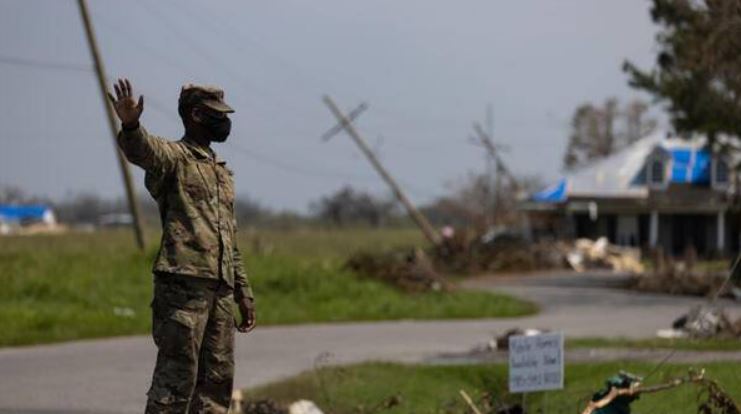
Hurricane Ida made landfall around 12 noon as a Cat. 4 storm on August 29 — the 10th anniversary of Hurricane Katrina — near Port Fourchon, LA, with sustained winds of 150 mph making it one of the most life-threatening storms to surge along the coasts of LA, MI and AL, then churning inland and upward throughout the Northeastern U.S. with historic and devastating flash flooding, threats to public health, safety, and infrastructure (including power outages).
Multiple federal and state agencies dependent on communications during a disaster like Ida do so through the Critical infrastructure (CI) within the U.S., whose complex and often interconnected system has become so expected that when events such as Hurricane Ida’s wrath affect that infrastructure it causes loss of electricity, transportation, water, healthcare and communications. Those who activate such communications are the soldiers and airmen assigned to the National Guard Bureau who coordinated Hurricane Ida response efforts from the National Guard Coordination Center in Arlington, VA, including those within the New Jersey Army National Guard [NJARNG] who ensured the transfer of communications and technology to essential resources and assets.
One CI system utilized within the NJARNG during Ida is the EMMIT, Emergency Management Mapping and Information Tracking system.
“When the New Jersey National Guard receives a request for support from a civilian agency, the
primary means of contact is a web-based application,” explained the U.S. Army Maj. Justin Moore, operations officer, NJNG Joint Operations Center, Lawrenceville, NJ.
“We’re also on the phone with the Trenton-based Regional Operation Intelligence Center which facilitates backup power generators,” he said. “In the event of a total blackout, we send a “runner” to relay messages. Fortunately, it hasn’t gotten to that point.”
“We can communicate with our airframes over UHF and VHF, which can also speak on the same band
as the New Jersey State Police,” Moore added.
According to Col. Frank Montgomery, director of military support, Pennsylvania National Guard, communications through the federal and state agencies during hurricane/storm Ida notes multiple sources of communications options.
“The Pennsylvania National Guard has several methods of communication available in the event of an unanticipated disaster to include phone, email, statewide radio, and even other methods such as high-frequency and some other satellite-based platforms such as ‘nano-shouts’,” said Montgomery.
A ‘nano-shout’ is slang for SHOUT Nano, a handheld global, two-way satellite messaging and personal tracking device that provides location information determined by a GPS receiver, two-way inbound and outbound status, text messaging, and emergency/alert notifications. The SHOUT Nano has an internal 1.95 AHr rechargeable Li-Ion battery, a high-resolution LCD screen, and a 011 alert button for emergency situations that measures 4.0”x2.2”x0.8” and weighs about 6.5 ounces making it suitable for easy concealment.
The SHOUT Nano by NAL Research can provide redundancy during a crisis which is a powerful strategy knowing oftentimes information is not received or is misunderstood, notably when communicating with multiple sources throughout the state or region.
“We have redundant power sources throughout the commonwealth at our facilities and we also work with our commercial partners to ensure we have priority access to cellular phone and email as part of the first responder team,” he said.
State resources include the State-branch of the Federal Emergency Management Agency [FEMA]such as the Pennsylvania Emergency Management Agency [PEMA].
“We coordinate and exercise these communications plans with the PEMA throughout the year, not just
during emergencies,” said Montgomery.
Fielding Communications Technology for the Future
As with all things technology, improvements, and advancements in communications are an ever-present need and the reality to source the right option aligned with the state’s budget is paramount.
“The Pennsylvania National Guard is currently fielding new radios that afford state-wide coverage and complete inter-agency connectivity,” explained Montgomery. “These new radios will replace older model 800mhz and will allow our personnel the ability to reach out to all of our interagency partners, with some prior coordination regarding frequencies. We also use other internet-based communication methods to ensure we are sending and receiving the latest information to our inter-agency counterparts.
Montgomery added that the PA-NG also has several satellite platforms that provide connectivity that are commercial and tailored for domestic operations, in addition to tactical communications that aren’t used
very frequently during domestic operations.”
In another area of Pennsylvania, Lt. Col. Randy Lutz, commander, of Eastern Army National Guard Aviation Training Site (EAATS) Fort Indiantown Gap, PA shared how his region utilizes communications assets through natural disasters like Ida.
“The federal and state agencies employ a PACE plan (Primary, Alternate, Contingency, Emergency) communications plan to support effective communication during federal and state domestic operations and contingency operations,” said Lutz. “Advances in technology deliver adaptive capabilities, access to interact with emergency management dashboards for situational awareness, planning, use of digital and Over The Horizon communications, and asset tracking.”
With respect to future communications systems needed, Lutz said, “The federal and state agencies integrate a variety of communications platforms and diverse capabilities, including analog, digital, encrypted, employed via network, ground, air and geospatial means to manage disaster and emergency response.”